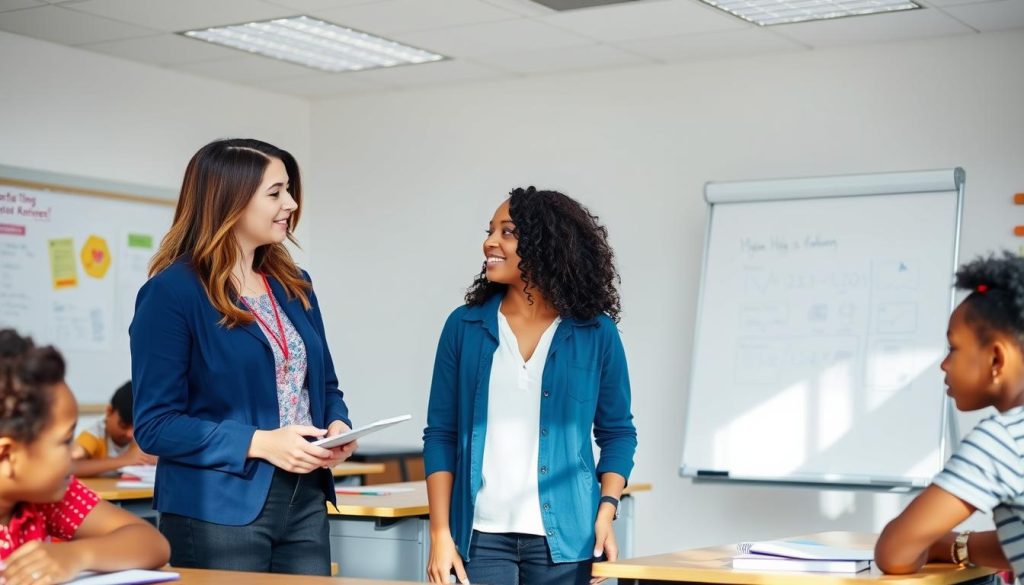What Is Co-Teaching?
Co-teaching brings together the expertise of multiple educators to enhance the learning experience.
Co-teaching is an instructional approach where two or more educators share responsibility for planning, delivering, and assessing curriculum for a single group of students. Typically, this involves pairing a general education teacher with a special education teacher, though other combinations exist. What makes co-teaching powerful is that it combines different teacher skills and perspectives to create a more responsive and effective learning environment.
Unlike traditional teaching models where one teacher manages everything, co-teaching distributes responsibilities and leverages the unique strengths of each educator. This collaborative approach has gained significant traction in recent years, particularly as schools move toward more inclusive practices. According to data from the U.S. Department of Education, approximately 67% of students with emotional disabilities now spend at least 80% of their school day in general education classrooms, highlighting the growing need for effective co-teaching strategies.
The foundation of successful co-teaching rests on two key components: “cognitive contract” and “emotional consonance” between teachers. Cognitive contract refers to shared educational beliefs that value inclusive education, while emotional consonance involves trust and honest communication between co-teachers. These elements emphasize that effective co-teaching relies on both shared goals and strong professional relationships.
Co-Teaching Models That Support Student Learning
There are several distinct co-teaching approaches, each offering unique benefits for supporting student learning. Understanding these models helps teachers select the most appropriate approach based on their instructional goals, student needs, and teacher skills.
Team Teaching
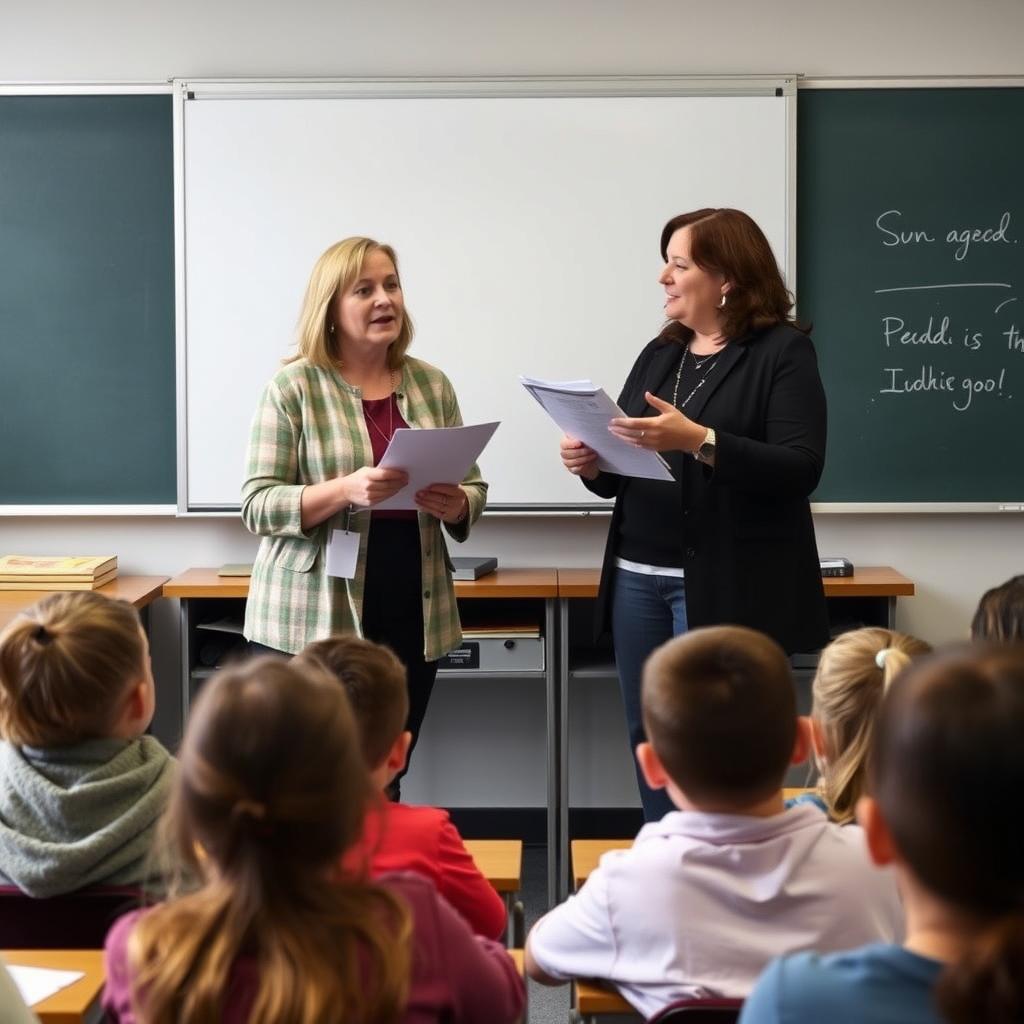
In team teaching, both educators jointly deliver instruction to the entire class. This approach showcases fluid partnership where teachers alternate roles seamlessly. For example, one teacher might explain a science concept while the other performs a related experiment, demonstrating the practical application. This model requires strong teacher skills in communication and coordination but offers students the benefit of multiple perspectives and teaching styles.
Parallel Teaching
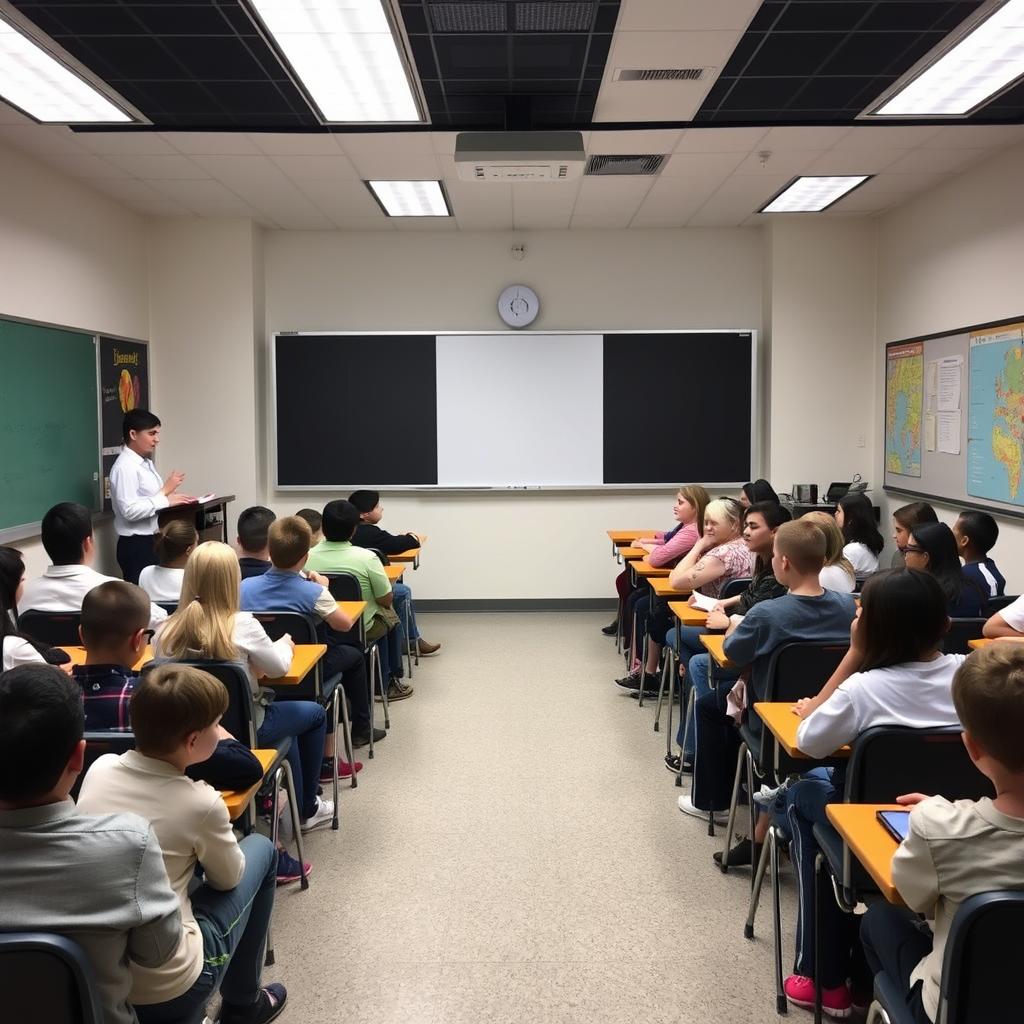
Parallel teaching involves dividing the class into two groups, with each teacher delivering the same content simultaneously. This approach reduces the student-teacher ratio, allowing for more individualized attention and increased participation opportunities. For instance, during a literature discussion, each teacher might lead a smaller group conversation about the same text, enabling more students to share their thoughts and receive feedback.
Station Teaching
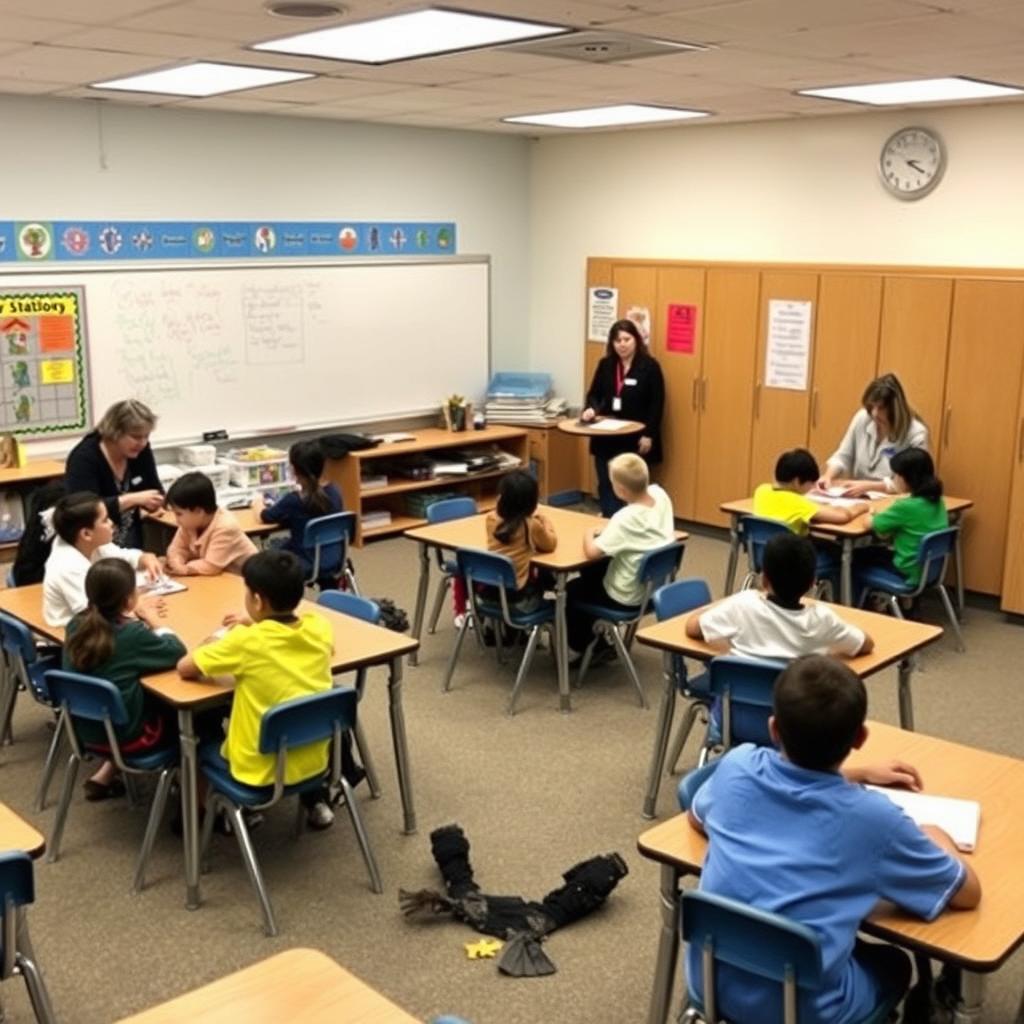
Station teaching divides students into small groups that rotate between different learning centers. Each teacher facilitates one station, while additional stations might involve independent or peer-collaborative work. This model is particularly effective for developing teacher skills in differentiated instruction and classroom management. For example, in a math class, one station might focus on problem-solving with teacher guidance, another on skill practice with the second teacher, and a third on application through games.
Alternative Teaching
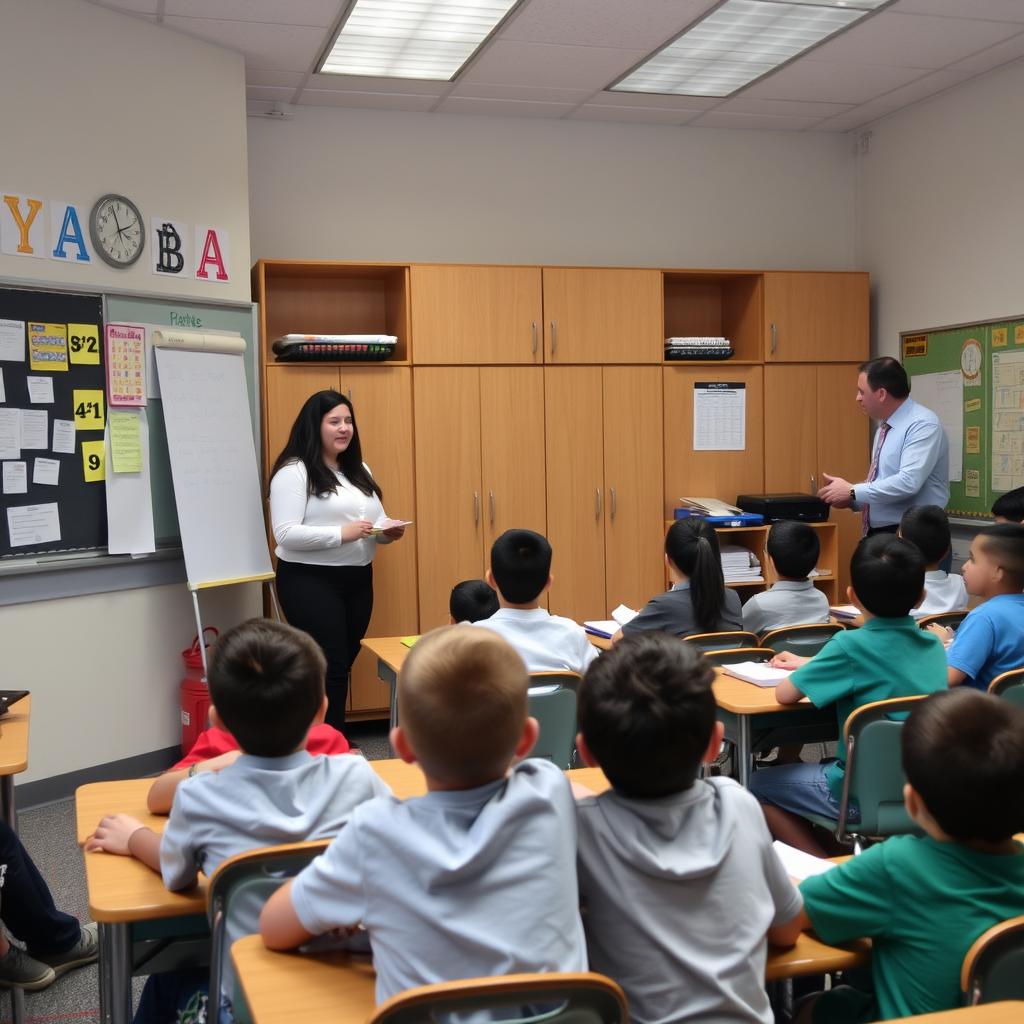
In alternative teaching, one educator works with a smaller group of students who need specialized attention while the other teaches the larger group. This approach is valuable for pre-teaching concepts, providing remediation, or extending learning for advanced students. For instance, a special education teacher might work with a small group on foundational skills while the general education teacher introduces new content to the rest of the class.
One Teach, One Observe
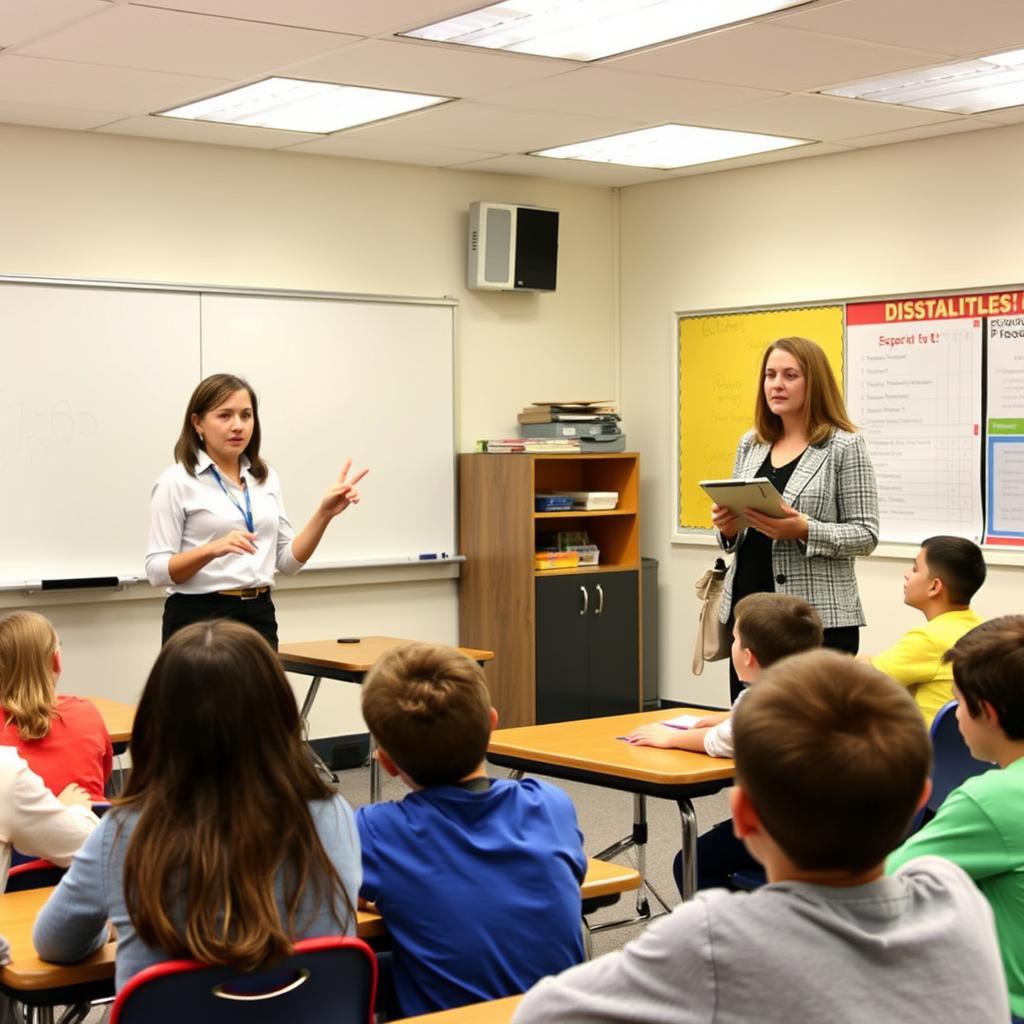
In this approach, one teacher leads instruction while the other gathers specific observational data about students. This model helps develop teacher skills in assessment and allows for targeted interventions based on detailed observations. For example, while one teacher conducts a writing lesson, the other might observe which students struggle with organizing their thoughts, providing valuable insights for future instruction.
One Teach, One Assist
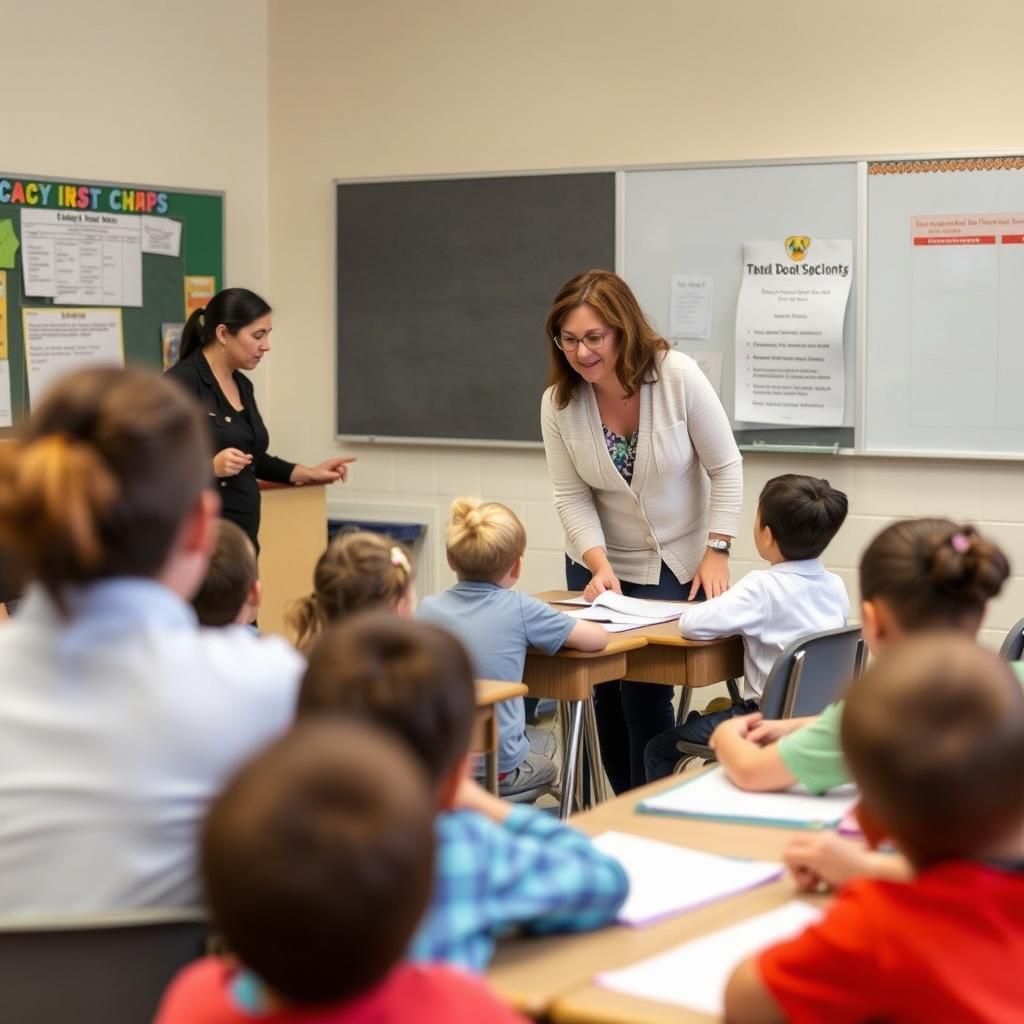
With one teach, one assist, the primary teacher delivers instruction while the secondary teacher circulates to provide individual support. This model is often used when introducing co-teaching or when specific students need additional guidance. While this approach is common, research suggests it’s most effective when roles are regularly switched to maintain equal teacher status in the classroom and develop diverse teacher skills.
Enhance Your Co-Teaching Skills
Looking to implement these co-teaching models effectively in your classroom? Our comprehensive co-teaching course provides step-by-step guidance, practical templates, and video demonstrations of each model in action.
How Co-Teaching Strategies Support Student Learning
The benefits of co-teaching extend far beyond simply having two teachers in the room. Research consistently shows that when implemented effectively, co-teaching strategies can significantly enhance student outcomes across multiple dimensions.
Benefits of Co-Teaching for Students
- Reduced student-teacher ratio allowing for more individualized attention
- Exposure to different teaching styles and perspectives
- Increased opportunities for participation and engagement
- More immediate feedback and support during learning activities
- Better differentiated instruction to meet diverse learning needs
- Improved academic performance, particularly for students with disabilities
- Enhanced social integration in inclusive classroom environments
- Modeling of collaborative relationships and communication skills
Challenges to Address
- Potential confusion if co-teaching roles aren’t clearly defined
- Risk of special education teacher being relegated to assistant role
- Need for dedicated co-planning time that may be difficult to schedule
- Possible personality or teaching philosophy conflicts
- Inconsistent implementation without administrative support
- Difficulty maintaining parity between teachers
- Potential for student dependency on higher levels of support
- Need for ongoing professional development to refine teacher skills
Academic Benefits
Research demonstrates that co-teaching can lead to significant academic improvements. A 2024 study by Barron and Friend found that co-teaching models with precise classroom management procedures and joint accountability between teachers resulted in higher student achievement compared to traditional single-teacher classrooms. This is especially true when co-teachers move beyond the basic “one teach, one assist” model to more collaborative approaches.
The academic benefits are particularly pronounced for students with disabilities, who receive specialized support within the general education setting rather than being pulled out for separate services. This continuity promotes inclusivity, reduces learning interruption, and allows students to practice academic skills in authentic contexts alongside their peers.
Social-Emotional Benefits
Beyond academics, co-teaching creates a classroom environment that supports students’ social-emotional development. Having two teachers means more opportunities to establish positive student-teacher relationships, which research has linked to improved behavior and academic performance. The collaborative nature of co-teaching also provides students with models of effective communication, problem-solving, and teamwork.
Students in co-taught classrooms often report feeling more supported and less anxious about asking for help, as there’s usually a teacher available to assist them. This increased access to support helps develop student confidence and self-advocacy skills, which are essential for long-term success.
“When teachers invest time in building trust, planning together, and sharing responsibilities, co-teaching becomes a powerful tool to meet all students’ needs.”
– NYU Steinhardt Institute of Human Development and Social Change
Differentiation Benefits
One of the most significant advantages of co-teaching is the enhanced ability to differentiate instruction. With two educators in the room, there are more opportunities to:
- Provide multiple ways for students to access content
- Offer varied options for students to demonstrate their learning
- Adjust the pace of instruction for different learning needs
- Implement flexible grouping strategies based on ongoing assessment
- Provide targeted interventions without disrupting the flow of the lesson
For example, in a co-taught mathematics class, one teacher might work with a small group using manipulatives to build conceptual understanding, while the other guides students who are ready to apply the concepts to word problems. This simultaneous differentiation would be challenging for a single teacher to manage effectively.
Developing Teacher Skills for Effective Co-Teaching
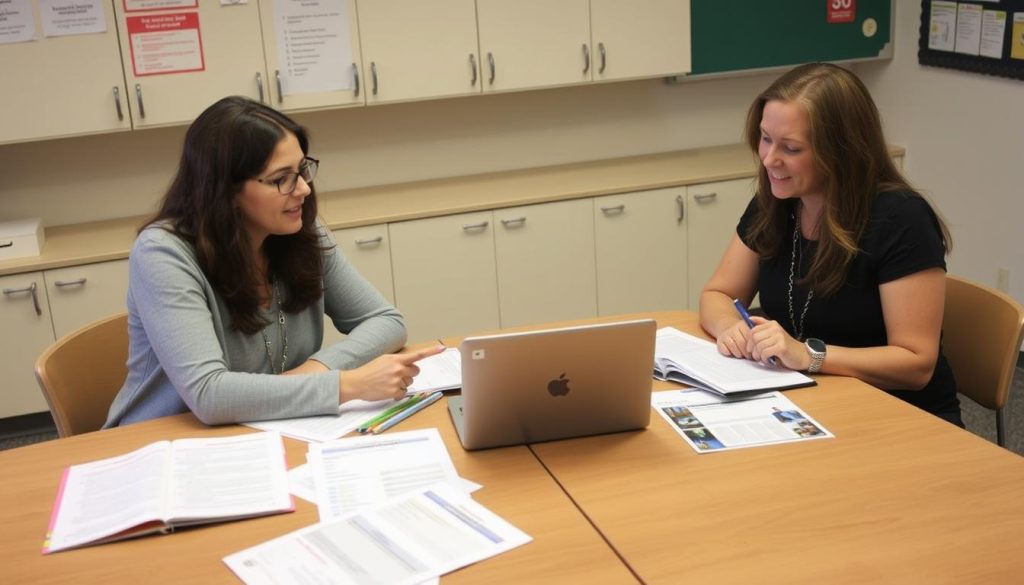
Successful co-teaching requires intentional development of collaborative teacher skills.
Effective co-teaching doesn’t happen automatically when two teachers are placed in the same classroom. It requires the development of specific teacher skills that facilitate collaboration, communication, and shared responsibility. Here are the essential teacher skills needed for successful co-teaching partnerships:
Communication Skills
Clear, honest communication forms the foundation of effective co-teaching. Teachers must develop skills in:
- Articulating teaching philosophies and preferences
- Providing constructive feedback to each other
- Discussing challenges openly without assigning blame
- Clarifying expectations about roles and responsibilities
- Developing a shared language around instruction and assessment
Collaborative Planning Skills
Co-planning is where the magic happens in co-teaching relationships. Essential teacher skills include:
- Establishing regular co-planning routines and protocols
- Sharing expertise without dominating the conversation
- Integrating specialized knowledge (content and special education)
- Creating lesson plans that utilize both teachers’ strengths
- Developing systems for documenting and tracking student progress
Flexibility and Adaptability
Co-teaching requires teachers to be flexible in their approaches. Key teacher skills include:
- Willingness to try different co-teaching models
- Ability to adjust instruction based on in-the-moment assessment
- Openness to different teaching styles and methods
- Comfort with shifting roles based on lesson objectives
- Adaptability when lessons don’t go as planned
Conflict Resolution Skills
Even the best co-teaching partnerships encounter challenges. Important teacher skills include:
- Addressing disagreements professionally and promptly
- Focusing on student needs when making decisions
- Separating personal preferences from pedagogical necessities
- Compromising when appropriate
- Seeking administrative support when needed
Teacher Skills Self-Assessment
Rate yourself on these essential co-teaching skills using a scale of 1-5, with 5 being strongest:
- I can clearly articulate my teaching philosophy and preferences.
- I am comfortable sharing instructional responsibilities.
- I can give and receive constructive feedback professionally.
- I am flexible about trying different teaching approaches.
- I make time for collaborative planning and reflection.
- I can adapt quickly when lessons need adjustment.
- I address conflicts directly and constructively.
- I actively seek to learn from my co-teacher’s expertise.
Areas where you scored 3 or below may indicate teacher skills to prioritize for development.
Developing these teacher skills takes time and intentional practice. Many schools provide professional development specifically focused on co-teaching, but teachers can also enhance their skills through peer observation, mentoring relationships, and professional learning communities.
Strengthen Your Co-Teaching Partnership
Looking for practical strategies to enhance your collaborative teacher skills? CreditsForTeachers.com offers professional development opportunities specifically designed for co-teaching teams.
Measuring How Co-Teaching Supports Student Learning
To ensure that co-teaching efforts are effectively supporting student learning, it’s essential to establish clear methods for measuring impact. This data-driven approach helps co-teachers refine their practices and demonstrate the value of their collaborative work.
Academic Performance Indicators
When evaluating how co-teaching supports student learning academically, consider collecting data on:
- Formative and summative assessment results
- Progress toward IEP goals for students with disabilities
- Growth measures on standardized tests
- Work samples showing development over time
- Rates of assignment completion and quality
Engagement and Participation Metrics
Co-teaching should increase student engagement. Measure this through:
- Systematic observation of student participation rates
- Student self-assessments of engagement
- Tracking of on-task behavior during different co-teaching models
- Attendance and punctuality patterns
- Levels of student-initiated questions and discussions
Social-Emotional Indicators
Effective co-teaching supports students’ social-emotional development. Monitor:
- Classroom climate surveys
- Behavioral referral data
- Student self-efficacy measures
- Peer relationship quality
- Student comfort seeking help from either teacher
| Co-Teaching Model | Data Collection Method | What to Look For |
| Team Teaching | Video analysis, peer observation | Seamless transitions, balanced teacher talk, student engagement with both teachers |
| Parallel Teaching | Participation tallies, formative assessment comparison | Increased participation rates, comparable learning outcomes between groups |
| Station Teaching | Station completion data, student feedback | Mastery of skills at each station, student preferences and challenges |
| Alternative Teaching | Pre/post assessments, student interviews | Growth in targeted skills, student comfort with flexible grouping |
| One Teach, One Observe | Structured observation protocols, targeted data collection | Patterns in student behavior, identification of learning barriers |
| One Teach, One Assist | Intervention tracking, time sampling | Frequency and effectiveness of individual supports, equitable attention to all students |
Reflection and Continuous Improvement
Beyond collecting data, co-teachers should establish regular reflection routines to analyze how their partnership is supporting student learning. Consider implementing:
- Weekly co-reflection meetings focused on student outcomes
- Quarterly analysis of trend data
- Student feedback surveys about co-teaching effectiveness
- Peer observation with specific focus areas
- Video analysis of co-taught lessons
This ongoing cycle of data collection, analysis, and reflection helps co-teachers continuously refine their practice to better support student learning. It also provides valuable evidence when advocating for resources, planning time, and professional development to enhance co-teaching effectiveness.
Overcoming Challenges to Support Student Learning
While co-teaching offers tremendous benefits for supporting student learning, implementing it effectively comes with challenges. Recognizing and proactively addressing these obstacles is essential for successful co-teaching partnerships.
Time Constraints
Perhaps the most frequently cited challenge in co-teaching is finding adequate time for collaborative planning. Without sufficient planning time, co-teaching can devolve into a primary/assistant dynamic rather than a true partnership.
Solutions for Planning Time Challenges:
- Request dedicated co-planning time in the master schedule
- Develop efficient planning protocols that maximize limited time
- Use shared digital documents for asynchronous planning
- Consider occasional before/after school planning sessions
- Request coverage for extended planning blocks monthly
Role Clarity and Parity
Maintaining equal status and clear roles between co-teachers can be challenging, particularly when one teacher has subject-specific expertise and the other brings special education knowledge. Without intentional effort, the special education teacher may be relegated to a supporting role rather than a true co-teacher.
To address this challenge, co-teachers should explicitly discuss their roles, responsibilities, and expectations. Creating a co-teaching agreement that outlines how responsibilities will be shared helps establish parity from the beginning. Additionally, regularly switching roles within different co-teaching models ensures that both teachers are seen as equally authoritative by students.
Philosophical Differences
Co-teachers often bring different teaching philosophies, classroom management approaches, and instructional preferences to the partnership. These differences can create tension if not addressed openly.
Successful co-teachers recognize that philosophical differences can actually strengthen their practice by providing students with multiple perspectives and approaches. The key is to discuss these differences honestly, find common ground in core values about student learning, and develop shared classroom routines that incorporate elements from both teachers’ approaches.
Administrative Support
Without strong administrative support, co-teaching initiatives often struggle to reach their full potential. School leaders play a crucial role in creating the conditions for successful co-teaching by:
- Providing adequate common planning time
- Offering professional development on co-teaching models and teacher skills
- Creating master schedules that facilitate effective co-teaching
- Establishing clear expectations for co-teaching implementation
- Recognizing and celebrating successful co-teaching partnerships
Teachers can advocate for these supports by documenting the impact of their co-teaching on student learning and sharing this evidence with administrators.
Student Resistance
Sometimes students, particularly those who have become accustomed to traditional classroom structures, may initially resist co-teaching approaches. They might be confused about which teacher to approach for help or feel uncomfortable with the increased attention that comes with having two teachers.
To address this challenge, co-teachers should explicitly teach students about the co-teaching model, explaining how having two teachers benefits their learning. Establishing consistent routines and clearly communicating expectations helps students adjust to the co-taught environment. Over time, most students come to appreciate the additional support and varied perspectives that co-teaching provides.
Navigate Co-Teaching Challenges Successfully
Need strategies to overcome specific co-teaching challenges? Our comprehensive guide provides practical solutions based on research and classroom experience.
Professional Development to Support Student Learning Through Co-Teaching
Ongoing professional development is essential for refining teacher skills and maximizing the impact of co-teaching on student learning. Research consistently shows that co-teaching is most effective when teachers receive specific training in collaborative practices and continue to develop their skills over time.
Types of Professional Development for Co-Teachers
Formal Training

Structured workshops and courses specifically focused on co-teaching models, collaborative planning, and shared assessment practices. These formal learning opportunities provide the theoretical foundation and practical strategies needed for effective co-teaching.
Peer Observation
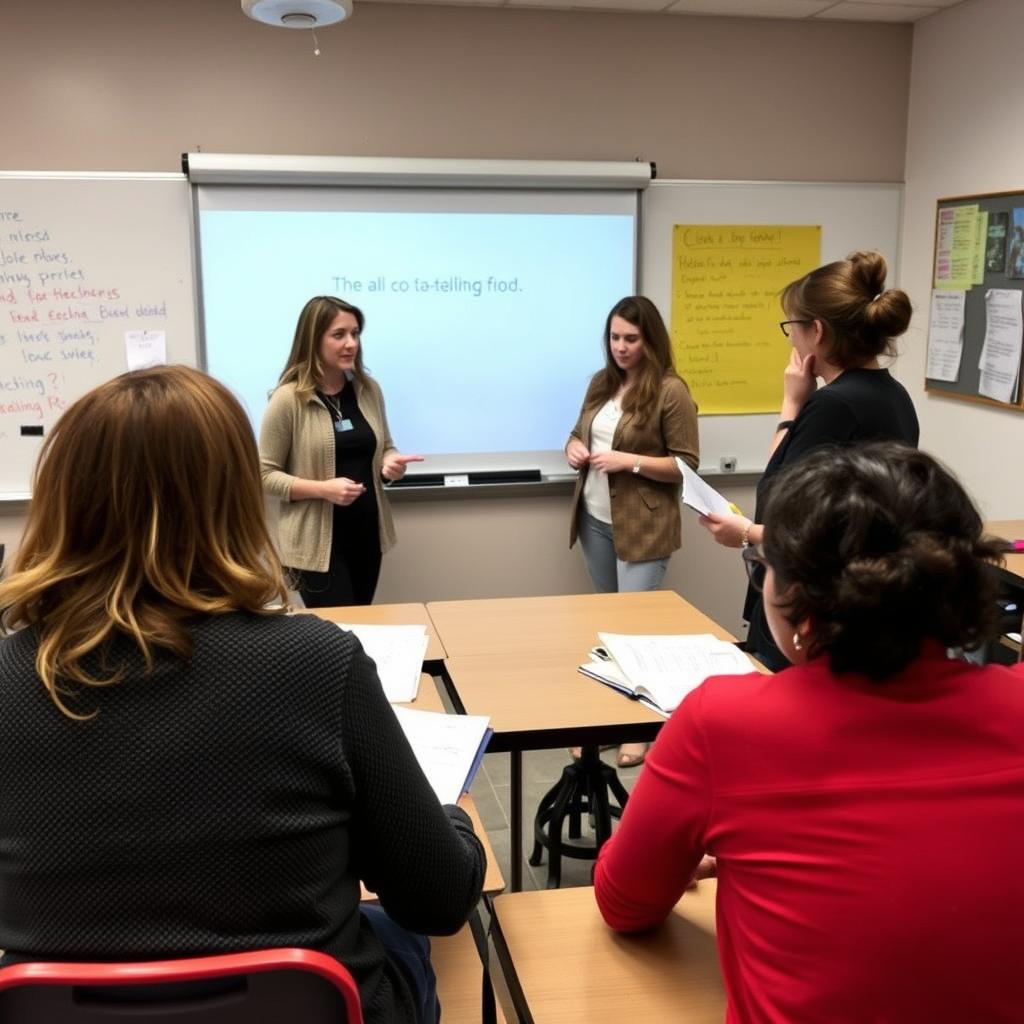
Visiting classrooms of experienced co-teaching pairs to observe different models in action. This type of professional development allows teachers to see real-world implementation of co-teaching strategies and gather ideas for their own practice.
Coaching
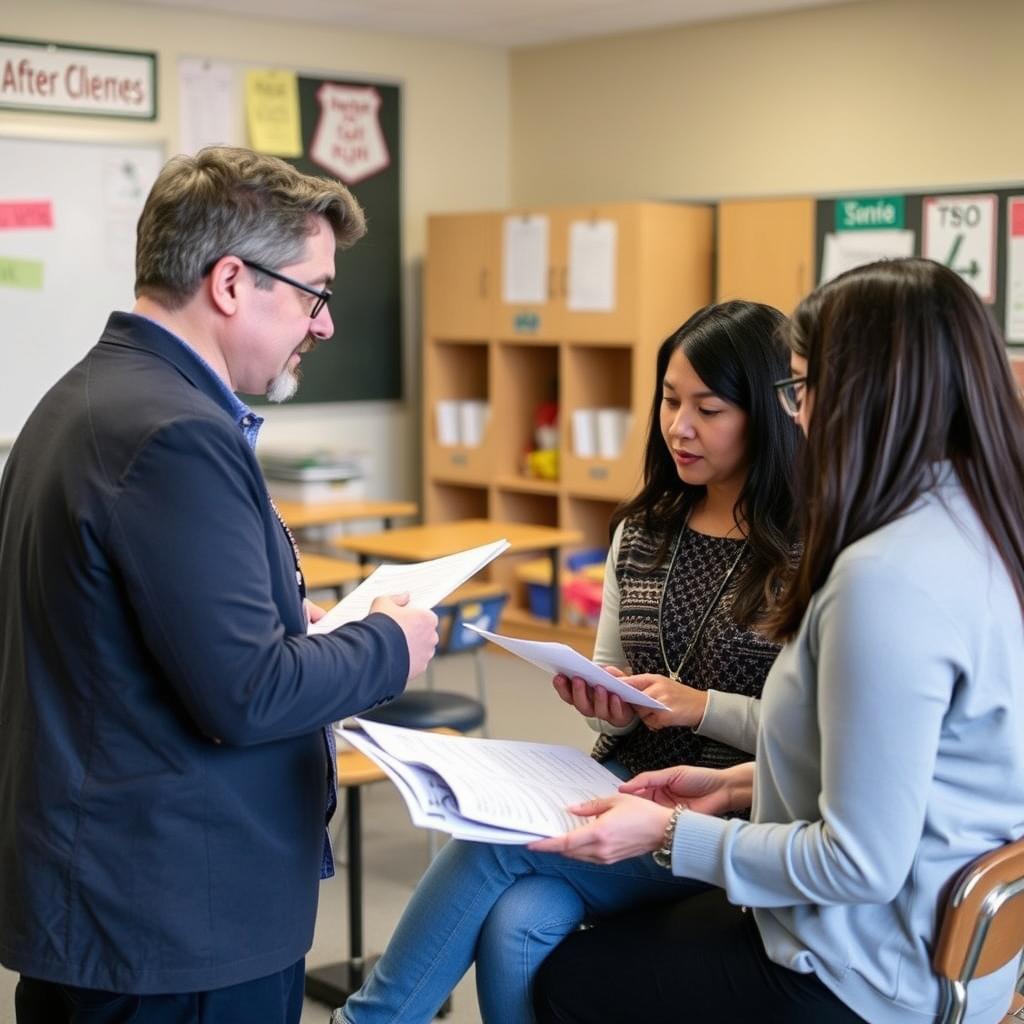
Ongoing support from an experienced co-teaching coach who observes lessons, provides feedback, and helps troubleshoot challenges. Coaching provides personalized guidance that addresses the specific needs and context of each co-teaching partnership.
Essential Content for Co-Teaching Professional Development
Effective professional development for co-teachers should address the following key areas:
Co-Teaching Models
- Understanding the six co-teaching approaches
- Selecting appropriate models based on learning objectives
- Transitioning smoothly between different models
- Adapting models to fit specific content areas
Collaborative Planning
- Establishing efficient planning routines
- Using planning templates designed for co-teaching
- Integrating specialized expertise into lesson design
- Creating lessons that utilize both teachers effectively
Shared Assessment Practices
- Developing common assessment approaches
- Collaboratively analyzing student data
- Using assessment to inform instructional decisions
- Providing consistent feedback to students
Relationship Building
- Establishing trust and open communication
- Navigating different teaching styles and preferences
- Addressing conflicts constructively
- Celebrating successes and sharing responsibilities
Self-Directed Professional Learning
In addition to formal professional development, co-teachers can enhance their practice through self-directed learning activities:
- Reading professional literature on co-teaching practices
- Joining online communities of co-teaching practitioners
- Keeping a reflective journal about co-teaching experiences
- Recording and analyzing lessons to identify areas for improvement
- Creating a professional learning network with other co-teachers
By engaging in ongoing professional development, co-teachers continuously refine their teacher skills and enhance their ability to support student learning through collaborative instruction.
Enhance Your Co-Teaching Practice
Ready to take your co-teaching to the next level? Our comprehensive online course provides research-based strategies, practical tools, and video examples to help you maximize student learning through effective co-teaching.
Conclusion: The Power of Co-Teaching to Support Student Learning
Co-teaching represents one of the most powerful approaches available to educators for supporting student learning in diverse classrooms. When implemented with intention and skill, co-teaching creates learning environments where all students can thrive academically, socially, and emotionally.
The research is clear: effective co-teaching leads to improved outcomes for students with and without disabilities. By combining the content expertise of general educators with the specialized instructional knowledge of special educators, co-teaching creates a synergy that benefits the entire classroom community. Students receive more individualized attention, experience multiple teaching approaches, and see models of collaborative problem-solving in action.
However, successful co-teaching doesn’t happen automatically. It requires developing specific teacher skills, establishing strong collaborative relationships, and committing to ongoing reflection and improvement. The challenges of finding planning time, maintaining parity between teachers, and navigating different teaching styles are real, but they can be overcome with administrative support and professional development.
As you consider implementing or refining co-teaching in your own context, remember that the journey toward effective collaboration is ongoing. Start with small steps, celebrate successes, address challenges openly, and keep student learning at the center of all decisions. With time and intentional effort, your co-teaching partnership can become a powerful vehicle for supporting student learning and creating truly inclusive classrooms.
For additional resources, professional development opportunities, and a supportive community of co-teaching practitioners, visit CreditsForTeachers.com. Together, we can harness the full potential of co-teaching to support student learning and success.

